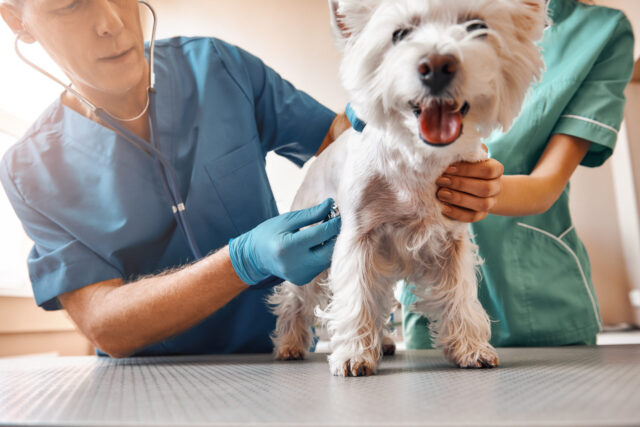
With so many people in quarantine during the pandemic, animal lovers everywhere realized they had extra time to care for a new furry friend. This led to what is now referred to as the “pandemic pet boom,” giving so many dogs and cats a forever family to call their own.
While this was a welcome change for the animal rescue world, it led to some unexpected repercussions that are now impacting both veterinary professionals and fur parents alike.

The Pandemic Pet Boom
According to the American Pet Products Association, over 12 million Americans welcomed a new pet into their home after March 2020. Shelters around the country were cleared faster than ever, and private pet purchases soared as well.
Not only did more citizens become pet parents, fewer owners surrendered animals to shelters than ever before. With these two factors combined, the pandemic pet boom began.

With so many furry friends finding forever homes, veterinary clinics around the country took a massive hit. The growing adoption rates led to a demand that nobody saw coming.
Vet Clinics Are Overwhelmed
The pandemic pet boom is overwhelming veterinary clinics for many reasons. As the number of new fur parents rises, so does the demand for veterinary care. Veterinary schools are unable to produce enough doctors and technicians to meet these demands, causing a waterfall effect that has touched every clinic.
Veterinary professionals are struggling to keep up with an increased need for wellness exams, vaccination appointments, emergency care, specialty care, and everything in-between. Nationwide veterinary company Banfield saw half a million more pets in 2020 than any year before, and that’s just one provider.
Devastating Staff Shortages
Not only are vet schools unable to churn out enough vets and technicians to meet the needs of the pandemic pet boom, but a large number of professionals are walking away from the field altogether. I discussed the sad reality of working in veterinary medicine in detail here, but a few main factors are driving hard workers out of their clinics.
Compassion fatigue is at an all-time high, strenuous working conditions have become the standard, scheduled shifts have turned into daily overtime, and bullying from clients has become a common occurrence.
Everyone is feeling the stress, and many have made the choice to leave because of it. Roles ranging from veterinarians to veterinary receptionists are vacant, and this has a devastating impact on both workers and pet owners.
Pet Parents Are Facing Long Wait Times
So what do you get when you combine a massive increase in pets and dwindling veterinary staff? Excruciatingly long wait times at your local animal hospital. Veterinary staff can only see so many pets in a day while still offering the quality care that your animal deserves.
Clinics around the US are booked out for weeks, with many vets seeing 5-8 more pets per shift than they did pre-pandemic. Not only are they caring for the scheduled appointments each day, but the many emergencies that pop up in between.
With my own experience working in an emergency animal hospital, I can attest to the increased wait times that clients are forced to face. They can get up to 8 hours on a busy day, and that’s with a flow of patients being seen constantly throughout the shift.
Clinics Forced To Turn Away Patients
When wait times are too long, and schedules are backlogged, vet clinics are forced to turn patients away. Some fur parents are struggling to find vets with availability in their area, many driving hours to find a clinic that can accept them.

Not only is it tough to squeeze your pet in for their yearly vaccines, but it can be challenging to receive emergency care as well. Some pet parents have begun to visit emergency facilities for their standard pet care, as their regular clinics do not have the availability to see them. This increases the standard wait times at emergency animal hospitals and forces doctors to turn patients away when their hospital is full.
Is There A Solution?
Pandemic pets are here to stay, and the demand for veterinary care is not going anywhere anytime soon. So how do we solve this problem? After speaking with my colleagues, we have come up with a few effective methods to ease the burden on everyone:
- Schedule your pet’s annual exams 2-3 months in advance.
- Keep up with your pet’s yearly and monthly preventative care, as this will decrease their chances of getting sick.
- Make sure your pet’s medications are refilled before they run out.
- Be open to dropping your pet off at the vet for the day, as this will allow the staff to perform their care at their availability.
- Be kind to your veterinary team. They are trying their best to get your pet seen as quickly as possible.
- Always choose a reputable breeder when purchasing a pet. This will help to prevent the possibility of taking home a sick puppy or kitten.
H/T: theguardian.com, stltoday.com
The post Vet Clinics Struggle To Keep Up In The Aftermath Of The Pandemic Pet Boom appeared first on iHeartDogs.com.
from iHeartDogs.com https://ift.tt/3moFFVl https://ift.tt/3FhDcVm


No comments:
Post a Comment